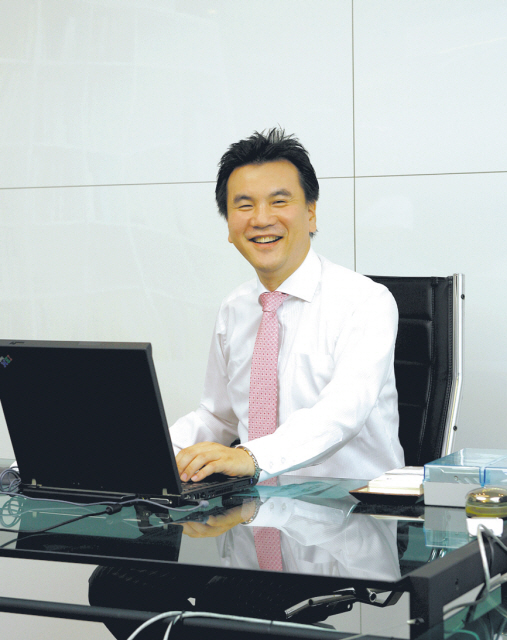Global No. 1 industrial camera maker eyes growth in OLED, X-ray markets
Liquid crystal display manufacturing involves sophisticated technology.
It also involves high-end inspection equipment and systems to make sure manufacturers such as Samsung Electronics can produce the world’s top quality LCDs.
High-performance industrial cameras such as those made by Vieworks are crucial parts of such equipment that can detect even the tiniest flaws, unnoticeable to the human eye, before products are shipped to customers.
Vieworks may not be a household brand as Canon and Nikon are in consumer digital cameras, but it is globally the top tech company in high-resolution cameras for enterprises.
Its 29-megapixel cameras are widely used by the LCD industry, largely thanks to Samsung Electronics, which has designated Vieworks products for use at most of its equipment suppliers, said Kim Hoo-shik, CEO of the Korean industrial camera maker.
Liquid crystal display manufacturing involves sophisticated technology.
It also involves high-end inspection equipment and systems to make sure manufacturers such as Samsung Electronics can produce the world’s top quality LCDs.
High-performance industrial cameras such as those made by Vieworks are crucial parts of such equipment that can detect even the tiniest flaws, unnoticeable to the human eye, before products are shipped to customers.
Vieworks may not be a household brand as Canon and Nikon are in consumer digital cameras, but it is globally the top tech company in high-resolution cameras for enterprises.
Its 29-megapixel cameras are widely used by the LCD industry, largely thanks to Samsung Electronics, which has designated Vieworks products for use at most of its equipment suppliers, said Kim Hoo-shik, CEO of the Korean industrial camera maker.

“We also attribute this to developing cameras with high image noise reduction capability,” Kim told The Korea Herald.
This proprietary technology, simply put, allows photographs to be “crystal clear,” which is exactly what the industry needs to inspect tiny little pixel details in displays after production.
Its 29M cameras generate “ultra high-definition” images, which are more than ten times as sharp as the standard 2M HD cameras which have a frame rate of 30 frames per second. Given that a single shot taken by Vieworks’ 29M camera carries a massive amount of data, as the industry needs for in-depth analysis, it can only shoot four frames per second.
This is why only high-tech industries use these types of cameras, which are also often used for aerial photography to get clear shots of landscapes, as consumers would not be able to manage or handle such huge data.
With organic light-emitting diodes emerging as the next-generation display, Vieworks seeks to further boost the production of “Pixel Shift” industrial cameras for OLED display inspection with image resolution that is nine times higher than its existing 29M cameras for LCDs, Kim said.
The company is also looking to develop a new line of 29M industrial cameras that can inspect LCDs during production, as compared to its existing 29M cameras which inspect after production.
This is part of efforts to achieve 100 billion won in sales in three years, of which it aims to post sales of 50 billion won from its industrial cameras for LCD and OLED.
It seeks to achieve the rest from its medical imaging hardware and software business where the company has begun producing flat-panel X-ray detectors, the company’s new growth engine. The company posted sales of 35.3 billion won in total in 2011, and targets revenue of 48 billion this year.
Kim described the flat-panel detectors as “big sensors” that will replace still image processing for X-rays.
Vieworks started out as a developer of medical cameras and software for both still and moving pictures that produce higher resolution images than 2M HD cameras, before venturing into lucrative industrial cameras for LCDs in 2008.
Flat-panel detectors will be alternative solutions to still cameras, which had replaced traditional films in X-ray imaging systems, Kim said, adding that the company aims to become among the global top three in the sector in three years from its current position in fifth.
It was not all rosy or easy for Vieworks from the beginning to reach its current stage.
Kim, a life-long optics engineer, joined Vieworks as its chief executive in 2002 when Medison, which was its main shareholder and customer, was facing bankruptcy. Medison, a medical device maker, is now part of Samsung Electronics. Kim used to be an optics researcher for Samsung Aerospace Industries (Samsung Techwin).
Vieworks urgently needed a business model that could help bypass this financial storm and make profit. Thus, Kim headed the company to do what he believed it could do best ― optics engineering ― and began developing applications for medical and industrial cameras.
Due to experiencing such hardship back then, Kim said the company maintains zero debt while holding sufficient cash as “ammunition” for the unexpectedness in this competitive business environment.
The 135 billion won market cap company has constantly been listed as one of KOSDAQ’s “Hidden Champions” for posting continuous growth in its industry.
By Park Hyong-ki (hkp@heraldcorp.com)








![[Graphic News] More Koreans say they plan long-distance trips this year](http://res.heraldm.com/phpwas/restmb_idxmake.php?idx=644&simg=/content/image/2024/04/17/20240417050828_0.gif&u=)
![[KH Explains] Hyundai's full hybrid edge to pay off amid slow transition to pure EVs](http://res.heraldm.com/phpwas/restmb_idxmake.php?idx=644&simg=/content/image/2024/04/18/20240418050645_0.jpg&u=20240419100350)





![[From the Scene] Monks, Buddhists hail return of remains of Buddhas](http://res.heraldm.com/phpwas/restmb_idxmake.php?idx=652&simg=/content/image/2024/04/19/20240419050617_0.jpg&u=20240419175937)

![[KH Explains] Hyundai's full hybrid edge to pay off amid slow transition to pure EVs](http://res.heraldm.com/phpwas/restmb_idxmake.php?idx=652&simg=/content/image/2024/04/18/20240418050645_0.jpg&u=20240419100350)

![[Today’s K-pop] Illit drops debut single remix](http://res.heraldm.com/phpwas/restmb_idxmake.php?idx=642&simg=/content/image/2024/04/19/20240419050612_0.jpg&u=)